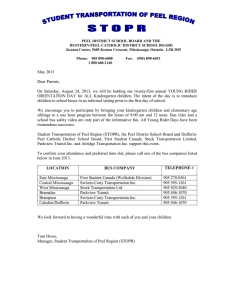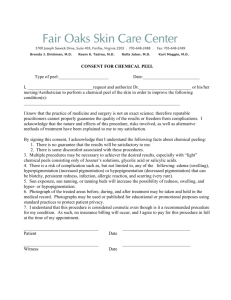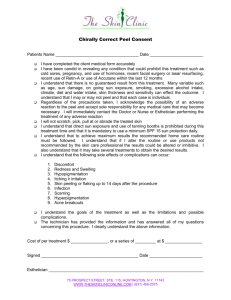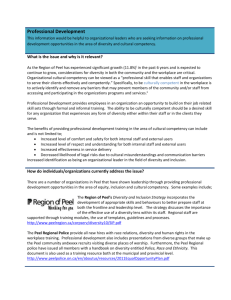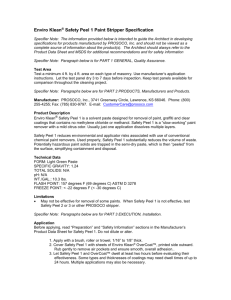Evaluating Public Health Impacts of Land Use
advertisement
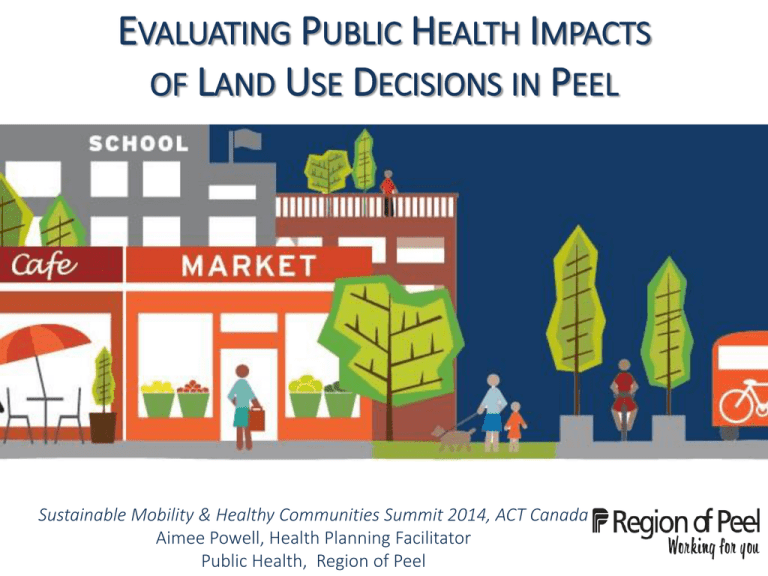
EVALUATING PUBLIC HEALTH IMPACTS OF LAND USE DECISIONS IN PEEL Sustainable Mobility & Healthy Communities Summit 2014, ACT Canada Aimee Powell, Health Planning Facilitator Public Health, Region of Peel GREATER TORONTO AND HAMILTON AREA – The RRegion EGION OF Pof EELPeel Peel REGION OF PEEL • Peel’s population is 1.36 million and is anticipated to grow to 1.64 million by 2031 • Mix of urban, suburban and rural • Region is dominated by low density development • Five 400-series highways • Toronto Pearson International Airport located in Peel REGION OF PEEL: CALL TO ACTION INCREASED RISK OF DIABETES IN PEEL • Diabetes prevalence rates: – Peel Region 9.8 • Mississauga 9.46 • Brampton 11.34 • Caledon 7.67 – Greater Toronto 9.04 – Ontario 8.28 Source: Peel Diabetes Atlas, 2013 RELATIONSHIP BETWEEN AUTO-DEPENDENT DEVELOPMENT BUILT ENVIRONMENT AND PHYSICAL INACTIVITY DISEASE PREVENTION POWER WALKING & CYCLING Walking Cycling - Risk of death by 22% (29min/day * 7 days/week) - Risk of diabetes by 30% (2.5 hours/week) - Risk of death by 28% (3 hours/week *36 weeks/year) BIKE TO Bike to WORK? Work? WALK? Walk? PLANNINGand AND P UBLIC HEALTH Planning Public Health • Rationale: – Evidence to demonstrate the positive link between health and built environment • The Role of Public Health: – Develop evidence-based tools to assess health impacts – Influence local policies – Advocacy and support shared provincial and local goals HEALTHY DEVELOPMENT INDEX (HDI) A framework to provide consistent, quantifiable standards to inform planning decisions HDI consists of seven “elements” – categories of built environment characteristics that are known to be associated with health: Density | Proximity to Services and Transit | Land Use Mix | Street Connectivity | Road Network and Sidewalk Characteristics | Parking | Aesthetics and Human Scale Health Background Study HEALTH BACKGROUND STUDY FRAMEWORK (HBSF)(HBSF) Framework The HBSF formalizes the use of evidence-based public health considerations in the land use planning process and in turn maximizes the health promoting potential of local communities HBSF Includes: • Refined elements and measures • Terms of Reference • Visually-appealing user guide that aids implementation • Healthy Canada by Design project HEALTH ASSESSMENT TOOL REFINED HDI HBSF Health Assessment Checklist Assessing ASSESSING Health HEALTH IImpacts MPACTS Assessing health-related impacts of development proposals and providing considerations for health-promoting enhancement • Commenting on development applications: – Secondary Plans – Block Plans – Site Plans • Commenting on Environmental Assessment’s (EAs) – Pedestrian Friendly Environments – Active Transportation KEY LESSONS LEARNED • Issue Awareness • Multi-Disciplined Partnerships • Influential Champions • Piloting Tools KEY LESSONS LEARNED • Empowerment of Stakeholders • Consistency of Implementation • Monitoring and Evaluation of Health Assessment Tool Influencing INFLUENCING Planning PLANNING P Policies OLICIES Influencing local planning policies to reflect key elements of healthy built environments • Council Resolutions • Regional and Municipal Official Plan Amendments • City of Brampton, Sustainable Community Development Guidelines • Town of Caledon Mayfield West II Secondary Plan • City of Mississauga 2014 Urban Design Awards Health-Based Criteria SUPPORT SHARED GOALS Supporting shared provincial and local goals of compact design, congestion, growth management, public transit and sustainability Recommendations: • Strengthen provincial policies to support greater active transportation and public transit use • Normalize the planning for active transportation and public transit by municipalities IMPROVING HEALTH BY DESIGN www.healthypeelbydesign.ca http://www.peelregion.ca/health/resources/healthbydesign/pdf/highlights-report.pdf
